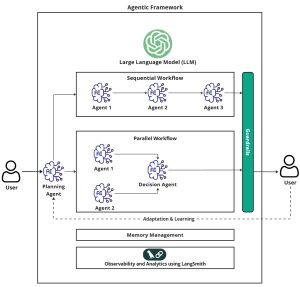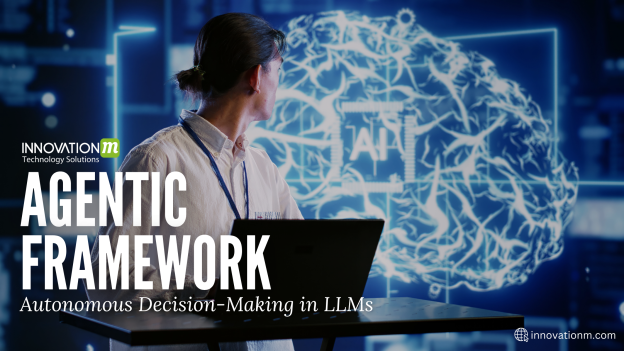For years, Large Language Models (LLMs) have impressed us with their ability to generate human-like responses, but they’ve always had a major limitation—they react rather than act. They answer questions but don’t take the initiative, they don’t plan ahead, and they certainly don’t adapt to new information on their own. This is where the Agentic Framework is changing the game. It allows AI to function like an intelligent agent—one that can think, plan, and act autonomously.

What is the Agentic Framework?
At its core, the Agentic Framework gives AI the ability to go beyond just answering prompts. Instead of being passive, agentic AI models can retain memory, plan out tasks, make decisions, and continuously improve their responses. Think of it as shifting from an AI that reacts to commands to one that actively works on solving problems with minimal human intervention.
Here’s how it works:
- Memory: AI remembers previous interactions and builds on them instead of starting from scratch every time.
- Planning: It breaks down complex tasks into smaller steps and follows a structured process.
- Execution: It interacts with APIs, databases, or even other AI models to perform real tasks beyond just text generation.
- Feedback Loops: The AI evaluates its own performance and adjusts its approach based on results and user feedback.
How Does LangGraph Enable Agentic AI?
One of the best tools to implement the Agentic Framework is LangGraph, which builds on LangChain. While LangChain is great for chaining LLM calls together, LangGraph goes a step further by enabling structured workflows where AI can remember, adapt, and refine its approach.
A Real-World Use Case: AI-Powered Research Assistant
A researcher looking to stay updated on breakthroughs in quantum computing would benefit from an AI-powered research assistant that can:
- Search multiple sources automatically, scanning academic papers, news articles, and reputable websites for the latest information.
- Analyze and summarize the key insights from these sources, presenting the findings in a structured format.
- Verify the information by cross-checking details against trusted sources, reducing the risk of misinformation.
- Refine and improve the results by asking clarifying questions to tailor the information to the researcher’s needs, and updating the findings as new research emerges.
This capability is not just theoretical, as AI research tools using frameworks like LangGraph are already being developed to assist scientists, analysts, and businesses in making informed decisions more efficiently.
Practical Applications of Agentic AI
The ability of AI to plan and take independent actions is already transforming industries. Here are a few practical applications:
Agentic AI chatbots in customer support can troubleshoot problems, process refunds, or even schedule appointments without human intervention, reducing the need for repetitive manual tasks.
In software development, agentic AI can write, debug, and optimize code, analyzing requirements and iterating based on feedback. This saves time and reduces errors in the development process.
In the finance sector, autonomous AI models can analyze market trends, detect fraud, and make investment recommendations based on real-time data, augmenting human decision-making.
A Non-Technical Example
To put this into perspective, imagine an AI-powered financial advisor. Instead of just answering one-off questions like “How can I save money?”, an agentic AI would:
- Analyze your spending habits – It will identify trends and pinpoint unnecessary expenses.
- Create a budget – It can develop a personalized plan based on your financial goals.
- Monitor and adjust – It would be able to track your financial progress and suggest changes over time.
- Provide proactive alerts – Notify you about potential risks, investment opportunities, or upcoming bill payments.
For the user, it feels less like interacting with a chatbot and more like having an intelligent, proactive financial assistant that learns and evolves with them.
The Future of AI: A Shift Towards Autonomy
The key advancements driving this shift include:
- The Agentic Framework, which incorporates memory, planning, execution, and feedback, allowing AI to be more autonomous and useful.
- Continued progress in LangGraph, reinforcement learning, and AI safety, making the dream of AI that can think, plan, and improve itself a reality.
These developments represent a significant step forward in the evolution of AI, transforming it from a passive tool into a more autonomous and capable agent. As AI systems become increasingly self-directed and adaptive, they are poised to play a greater role in assisting and complementing human capabilities.
 End to End Technology Solutions
End to End Technology Solutions
